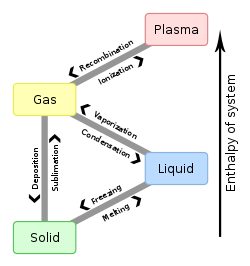Superglass
Appearance
It has been suggested that this article be merged into Supersolid. (Discuss) Proposed since June 2025. |
A superglass is hypothetical phase of matter which is characterized by superfluidity and a frozen amorphous structure at the same time.[1] This idea was put forward by Anthony James Leggett in 1970.[1][2]
In 2009, J.C. Séamus Davis theorised that frozen helium-4 (at 0.2 K and 50 atm) may be a superglass.[1][3][4]
Notes
[edit]- ^ a b c Giulio Biroli; Claudio Chamon; Francesco Zamponi (2008). "Theory of the superglass phase". Physical Review B. 78 (22): 19. arXiv:0807.2458. Bibcode:2008PhRvB..78v4306B. doi:10.1103/PhysRevB.78.224306. S2CID 3222218.
- ^ Leggett, A. J. (1970-11-30). "Can a Solid Be "Superfluid"?". Physical Review Letters. 25 (22): 1543–1546. doi:10.1103/PhysRevLett.25.1543.
- ^ "Press release: Supersolid or superglass? Cornell researchers study a strange state of matter in helium - Cornell Chronicle".
- ^ Yu, Xiaoquan; Mueller, Markus (2012). "Mean field theory of superglasses". Physical Review B. 85 (10): 104205. arXiv:1111.5956. Bibcode:2012PhRvB..85j4205Y. doi:10.1103/PhysRevB.85.104205. S2CID 119261743.
References
[edit]- Superglass could be new state of matter Archived 2012-02-27 at the Wayback Machine (subscription required)
- A new quantum glass phase: the superglass
- Phys. Rev. Lett. Vol.101, 8th Aug 2008

